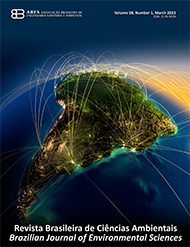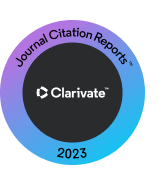Influence of the carbon-to-nitrogen ratio in the atrazine biodegradation from contaminated waters in submerged fermentation by free and immobilized Penicillium chrysogenum NRRL 807
DOI:
https://doi.org/10.5327/Z2176-94781905Palavras-chave:
pesticidas; degradadação por fungos; nitrogênio exógeno; biofilmes; tecnologia de biorremediação.Resumo
A atrazina é um pesticida comumente utilizado na agricultura, reconhecido como um potente disruptor endócrino. Dada a sua elevada recalcitrância, seus resíduos têm sido encontrados em mananciais de água potável pelo Brasil e pelo mundo. Diante disso, este estudo teve como objetivo avaliar a influência da relação C/N no potencial do fungo Penicillium chrysogenum NRRL 807 para degradar a atrazina em águas contaminadas em fermentação submersa, tanto em sua forma livre como na imobilizada (biofilmes). O fungo cultivado em cultura livre foi capaz de degradar 40,08±5,71% da atrazina presente no meio após cinco dias, enquanto o fungo imobilizado degradou 48,31±1,53% no mesmo tempo de incubação. Notavelmente, a atrazina foi utilizada como fonte de carbono e a degradação foi liderada pelo complexo enzimático do citocromo P450. Determinou-se que a quantidade de nitrogênio exógeno interfere na eficiência da biodegradação, desviando o metabolismo para a via de germinação de esporos quando o nitrogênio estava presente em altas concentrações. Com base nesses resultados, P. chrysogenum tanto em sua forma livre como em sua forma imobilizada em biofilmes pode ser usado como tecnologia de biorremediação para o tratamento de águas contaminadas por atrazina.
Downloads
Referências
Bachetti, R.A.; Urseler, N.; Morgante, V, Damiliano, G.; Porporato, C.; Agostini, E.; Morgante, C., 2021. Monitoring of atrazine pollution and its spatial-seasonal variation on surface water sources of an agricultural river basin. Bulletin of Environmental and Contamination Toxicology, v. 106, 929-935. https://doi.org/10.1007/s00128-021-03264-x
Blahova, J.; Cocilovo, C.; Plhalova, L.; Svobodova, Z.; Faggio, C., 2020. Embriotocixity of atrazine and its degradation products to early stages of zebrafish (Danio rerio). Environmental Toxicology and Pharmacology, v. 77, 103370. https://doi.org/10.1016/j.etap.2020.103370
Böl, M.; Schrinner, K.; Tesche, S.; Krull, R., 2021. Challenges of influencing cellular morphology by morphology engineering techniques and mechanical induced stress on filamentous pellet systems - a critical review. Engineering in Life Sciences, v. 21 (3-4), 51-67. https://doi.org/10.1002/elsc.202000060
Cabrera-Barjas, G.; Gallardo, F.; Nesic, A.; Taboada, E.; Marican, A.; Mirabal-Gallardo, Y.; Avila-Salas, F.; Delgado, N.; Valdes, O., 2020. Utilization of industrial by-product fungal biomass from Aspergillus niger and Fusarium culmorum to obtain biosorbents for removal of pesticide and metal ions from aqueous solutions. Journal of Environmental Chemical Engineering, v. 8 (5), 104355. https://doi.org/10.1016/j.jece.2020.104355
Chen, X.; Zhou, Q.; Liu, F.; Peng, Q.; Teng, P., 2019. Removal of nine pesticide residues from water and soil by biosorption coupled with degradation on biosorbent immobilized laccase. Chemosphere, v. 233, 49-56. https://doi.org/10.1016/j.chemosphere.2019.05.144
Cheng, Z.; Feng, K.E.; Su, Y.; Ye, J.; Chen, D.; Zhang, S.; Zhang, X.; Dionysiou, D.D, 2020. Novel biosorbents synthesized from fungal and bacterial biomass and their applications in the adsorption of volatile organic compounds. Bioresource Technology, v. 300, 122705. https://doi.org/10.1016/j.biortech.2019.122705
Córdova-Alcántara, I.M.; Vemegas-Cortés, D.L.; Martinéz-Rivera, M.A.; Pérez, N.O.; Rodrigues-Tovar, A.V., 2019. Biofilm caracterization of Fusarium solani keratitis isolate: increased resistance to antifungals and UV light. Journal of Microbiology, v. 57 (6), 485-97. https://doi.org/10.1007/s12275-019-8637-2
Dash, D.M.; Osborne, W.J., 2020. Rapid biodegradation and biofilm-mediated bioremoval of organophosphorus pesticides using an indigenous Kosakonia oryzae strain-VITPSCQ3 in a Vertical-flow Packed Bed Biofilm Bioreactor. Ecotoxicology and Environmental Safety, v. 192, 110290. https://doi.org/10.1016/j.ecoenv.2020.110290
Dhiman, N.; Jasrotia, T.; Sharma, P.; Negi, S.; Chaudhary, S.; Kumar, R.; Mahnashi, M.H.; Umar, A.; Kumar, R., 2020. Immobilization interaction between xenobiotic and Bjerkandera adusta for the biodegradation of atrazine. Chemosphere, v. 257, 127060. https://doi.org/10.1016/j.chemosphere.2020.127060
Eldin, A.M.; Al-Sharnouby, S.F.S.; ElGabry, K.I.M.; Ramadan, A.I., 2022. Aspergillus terreus, Penicillium sp. and Bacillus sp. isolated from mangrove soil having laccase and peroxidase role in depolymerization of polyethylene bags. Process Biochemistry, v. 118, 215-226. https://doi.org/10.1016/j.procbio.2022.04.030
Farhan, M.; Ahmad, M.; Kanwal, A.; Butt, Z.A.; Khan, Q.F.; Raza, S.A.; Qayyum, H.; Wahid, A., 2021. Biodegradation of chlorpyrifos using isolates from contaminated agricultural soil, its kinetic studies. Scientific Reports, v. 11 (1), 10320. https://doi.org/10.1038/s41598-021-88264-x
Galbiati, V.; Buoso, E.; Bianca, R.; Di Paola, R.; Morroni, F.; Nocentini, G.; Racchi, M.; Viviani, B.; Corsini, E., 2021. Immune and nervous systems interaction in endocrine disruptors toxicity: the case of atrazine. Frontiers in Toxicology, v. 3, 1-10. https://doi.org/10.3389/ftox.2021.649024
Harding, M.W.; Marques, L.L.R.; Howard, R.J.; Olson, M.E., 2009. Can filamentous fungi form biofilms? Trends in Microbiology, v. 17 (11), 475-480. https://doi.org/10.1016/j.tim.2009.08.007
Henn, C.; Monteiro, D.A.; Boscolo, M.; Silva, R.; Gomes, E., 2020. Biodegradation of atrazine and lignolytic enzime production by basidiomycetes strains. BMC Microbiology, v. 20 (266), 1-12. https://doi.org/10.21203/rs.3.rs-19578/v2
Herrera‐Gallardo, B.E.; Guzmán‐Gil, R.; Colín‐Luna, J.A.; García‐Martínez, J.C.; León‐Santiesteban, H.H.; González‐Brambila, O.M.; González‐Brambila, M.M., 2021. Atrazine biodegradation in soil by Aspergillus niger. The Canadian Journal of Chemical Engineering, v. 99 (4), 932-946. https://doi.org/10.1002/cjce.23924
Kaufman, D.D.; Blake, J., 1970. Degradation of atrazine by soil fungi. Soil Biology and Biochemistry, v. 2, 73-80. https://doi.org/10.1016/0038-0717(70)90010-6
Khindaria, A.; Grover, T.A.; Aust, S.D., 1994. Oxalate-dependent reductive activity of manganese peroxidase from Phanerochaete chrysosporium. Archives of Biochemistry and Biophysics, v. 314 (2), 301-306. https://doi.org/10.1006/abbi.1994.1446
Langer, L.T.A.; Staudt, K.J.; Carmo, R.L.; Alves, I.A., 2018. Biofilms in infection by Candida: a review of the literature. Revista Interdisciplinar em Ciências da Saúde e Biológicas, v. 2 (2), 1-15. https://doi.org/10.31512/ricsb.v2i2.2548
Lopes, R.D.O.; Pereira, P.M.; Pereira, A.R.B.; Fernandes, K.V.; Carvalho, J.F.; França, A.D.S.D.; Valente, R.; Silva, M.; Ferreira-Leitão, V.S., 2020. Atrazine, desethylatrazine (DEA) and desisopropylatrazine (DIA) degradation by Pleurotus ostreatus INCQS 40310. Biocatalysis and Biotransformation, v. 38 (6), 415-430. https://doi.org/10.1080/10242422.2020.1754805
Lu, J.; Li, R.; Chang, Y.; Zhang, Y.; Zhang, N.; Tao, L.; Xu, W., 2021. Effects of different parameters on the removal of atrazine in a water environment by Aspergillus oryzae biosorption. Journal of Pesticide Science, v. 46 (2), 214-221. https://doi.org/10.1584/jpestics.D20-043
Marinho, G.; Barbosa, B.C.A.; Rodrigues, K.; Aquino, M.; Pereira, L., 2017. Potential of the filamentous fungus Aspergillus niger AN 400 to degrade atrazine in wastewaters. Biocatalysis and Agricultural Biotechnology, v. 9, 162-167. https://doi.org/10.1016/j.bcab.2016.12.013
Mili, C.; Kalita, S.; Roy, S., 2023. Microbes as a potential bioremediation tool for atrazine-contaminated soil: a review. Journal of Applied Biology and Biotechnology, v. 11 (1), 8-15. https://doi.org/10.7324/JABB.2023.110102.
Mishra, S.; Huang, Y.; Li, J.; Wu, X.; Zhou, Z.; Lei, Q.; Bhatt, P.; Chen, S., 2022. Biofilm-mediated bioremediation is a powerful tool for the removal of environmental pollutants. Chemosphere, v. 294, 133609. https://doi.org/10.1016/j.chemosphere.2022.133609
Nouri, H.; Azin, E.; Kamyabi, A.; Moghimi, H., 2021. Biosorption performance and cell surface properties of a fungal-based sorbent in azo dye removal coupled with textile wastewater. International Journal of Environmental Science and Technology, v. 18, 2545-2558. https://doi.org/10.1007/s13762-020-03011-5
Papagianni, M., 2004. Fungal morphology and metabolite production in submerged mycelial processes. Biotechnology Advances, v. 22, 189-259. https://doi.org/10.1016/j.biotechadv.2003.09.005
Paul, G.C.; Kent, C.A.; Thomas, C.R., 1994. Hyphal vacuolation and fragmentation in Penicillum chrysogenum. Biotechnology and Bioengineering, v. 44, 655-660. https://doi.org/10.1002/bit.260440513
Saha, R.; Mukhopadhyay, M., 2022. Time-dependent electrochemical characteristics of a phenolic and non-phenolic compound in the presence of laccase/ABTS system. PLoS ONE, v. 17 (9), e0275338. https://doi.org/10.1371/journal.pone.0275338
Sánchez, O.F.; Lin, L.; Bryan, C.J.; Xie, J.; Freeman, J.L.; Yuan, C., 2020. Profiling epigenetic changes in human cell line induced by atrazine exposure. Environmental Pollution, v. 258, 113712. https://doi.org/10.1016/j.envpol.2019.113712
Singh, S.; Khan, N.A.; Ramadan, R.; Shehata, N.; Kapoor, D.; Dhanjal, D.S.; Sivaram, N.; Singh, J.; Barceló, D.; Ramamurthy, P.C., 2024. Environmental fate, toxicological impact, and advanced treatment approaches: atrazine degradation and emphasises on circular economy strategy. Desalination and Water Treatment, 100201. https://doi.org/10.1016/j.dwt.2024.100201
Šlosarčíková, P.; Novotný, C.; Malachová, K.; Válková, H.; Fojtík, J., 2017. Effect of yeasts on biodegradation potential of immobilized cultures of white rot fungi. Science of the Total Environment, v. 589, 146-52. https://doi.org/10.1016/j.scitotenv.2017.02.0790
Szewczyk, R.; Różalska, S.; Mironenka, J.; Bernat, P., 2020. Atrazine biodegradation by mycoinsecticide Metarhizium robertsii: Insights into its amino acids and lipids profile. Journal of Environmental Management, v. 262, 110304. https://doi.org/10.1016/j.jenvman.2020.110304
Su, X.; Wang, S.; Wang, X.; Ji, W.; Zhang, H.; Tu, T.; Hakulinen, N.; Luo, H.; Yao, B.; Zhang, W.; Huang, H., 2024. Targeting deoxynivalenol for degradation by a chimeric manganese peroxidase/glutathione system. Ecotoxicology and Environmental Safety, 273, 116130. https://doi.org/10.1016/j.ecoenv.2024.116130
Tang, K.H.D.; Lock, S.S.M.; Yap, P.S.; Cheah, K.W.; Chan, Y.H.; Yiin, C.L.; Ku, A.; Loy, A.; Chin, B.; Chai, Y.H., 2022. Immobilized enzyme/microorganism complexes for degradation of microplastics: A review of recent advances, feasibility and future prospects. Science of the Total Environment, v. 832, 154868. https://doi.org/10.1016/j.scitotenv.2022.154868
Urseler, N.; Bachetti, R.; Biolé, F.; Morgante, V.; Morgante, C., 2022. Atrazine pollution in groundwater and raw bovine milk: Water quality, bioaccumulation and human risk assessment. Science of The Total Environment, v. 852, 158498. https://doi.org/10.1016/j.scitotenv.2022.158498
Valle, J.S.; Vandenbergue, L.P.S.; Santana, T.T.; Linde, G.A.; Colauto, N.B.; Soccol, C.R., 2014. Optimization of Agaricus blazei laccase production by submerged cultivation with sugarcane molasses. African Journal of Microbiology Research, v. 8, 939-946. https://doi.org/10.5897/AJMR2013.6508
Vu, T.X.; Vu, H.H.; Nguyen, G.T.; Vu, H.T.; Mai, L.T.D.; Pham, D.; Le, D.H.; Nguyen, H.Q.; Tran, V., 2019. A newly constructed Agrobacterium-mediated transformation system revealed the influence of nitrogen sources on the function of the LaeA regulator in Penicillium chrysogenum. Fungal Biology, v. 123 (11), 830-842. https://doi.org/10.1016/j.funbio.2019.08.010
Wang, X.; Huang, Z.; Li, C.; Liu, M.; Yang, G.; Luo, L.; Rao, Y.; Shen, Y.; Wang, J., 2023. Biological characteristics of strain MJ1015 and optimization of solid medium technology for sporulation. Polish Journal of Microbiology, v. 72 (4), 377-389. https://doi.org/10.33073/pjm-2023-033
Wang, X.; Zhang, W.; Liu, Y.; Jia, Z.; Li, H.; Yang, Y.; Wang, D.; He, H.; Zhang, X., 2021. Identification of microbial strategies for labile substrate utilization at phylogenetic classification using a microcosm approach. Soil Biology and Biochemistry, v. 153, 107970. https://doi.org/10.1016/j.soilbio.2020.107970
Wirsching, J.; Pagel, H.; Ditterich, F.; Uksa, M.; Werneburg, M.; Zwiener, C.; Berner, D.; Kandeler, E.; Poll, C., 2020. Biodegradation of pesticides at the limit: kinetics and microbial substrate use at low concentrations. Frontiers in Microbiology, v. 11, 2107. https://doi.org/10.3389/fmicb.2020.02107
Yang, X.; Wei, H.; Zhu, C.; Geng, B., 2018. Biodegradation of atrazine by the novel Citricoccus sp. strain TT3. Ecotoxicology and Environmental Safety, v. 147, 144-150. https://doi.org/10.1016/j.ecoenv.2017.08.046
Yu, J.; He, H.; Yang, W. L.; Yang, C.; Zeng, G.; Wu, X., 2018. Magnetic bionanoparticles of Penicillium sp. yz11-22N2 doped with Fe3O4 and encapsulated within PVA-SA gel beads for atrazine removal. Bioresource Technology, v. 260, 196-203. https://doi.org/10.1016/j.biortech.2018.03.103
Zhang, X.; Guo, J.; Cheng, F.; Li, S., 2021. Cytochrome P450 enzymes in fungal natural product biosynthesis. Natural Product Reports, v. 38 (6), 1072-1099. https://doi.org/10.1039/D1NP00004G
Zhao, X.; Wang, L.; Ma, F.; Bai, S.; Yang, J.; Qi, S., 2017. Pseudomonas sp. ZXY-1, a newly isolated and highly efficient atrazine-degrading bacterium, and optimization of biodegradation using response surface methodology. Journal of Environmental Sciences, v. 54, 152-159. https://doi.org/10.1016/j.jes.2016.06.010
Downloads
Publicado
Como Citar
Edição
Seção
Licença
Copyright (c) 2024 Revista Brasileira de Ciências Ambientais (RBCIAMB)

Este trabalho está licenciado sob uma licença Creative Commons Attribution 4.0 International License.

























